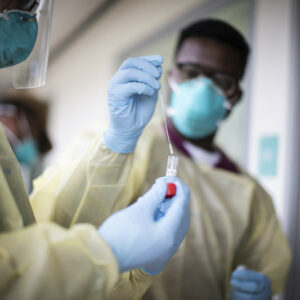
U.S. Sailors assigned to Fleet Surgical Team Three, Expeditionary Strike Group Three, hold a COVID-19 test swab while conducting COVID-19 testing in San Diego, California, June 22, 2020. (U.S. Marine Corps photo by Cpl. Dalton S. Swanbeck)
We have come a long way in understanding the coronavirus and responding to the resulting pandemic. It is ironic that little over a year into the public health emergency, a cohesive strategy to control the spread of the virus still eludes us. While it is unclear when—or even if—herd immunity might be achieved, one key to mitigating the devastating human and economic impact continues to be testing.
Moving forward, we must learn from our mistakes and implement best practices to overcome the current crisis. Also, we need to have learned from the pandemic and chaotic response to have the infrastructure in place to respond rapidly to the next pandemic, so we don’t make all the same mistakes.
One of the biggest stumbling blocks in our pandemic response was the lack of a national testing strategy. Although the scientific community and FDA worked around the clock to develop and authorize testing tools with unprecedented speed, the failure to implement comprehensive guidance hamstrung our response in those crucial early months, a challenge that has continued as new infectious variants have taken hold.
There was no clear, national testing plan and this made the coronavirus pandemic even more extreme in its impact. Public confidence in the government response was a casualty of the lack of a strategy. One result was a free-for-all among states to get access to limited testing supplies instead of a coordinated effort to get assets to state and localities hardest hit by the virus. Some governors went to the open market, including Maryland Gov. Larry Hogan who used personal ties to lock down supplies. As happens in a crisis, prices skyrocketed and communities struggled to get people tested.
Shortages led to long lines for testing and long turnaround times for results. I had a test early on during the crisis and it took over two weeks to get my results. Thankfully, my results were negative. It took far too long to transition from a two-week turnaround to making sure Americans can get faster, more timely results.
As health officials warned of a winter surge heading into the holidays late in 2020, many Americans were forced to stand in line for hours to get tested, while others were turned away because testing sites had already hit capacity. An inefficient contact tracing policy contributed to further community spread as asymptomatic people did not know they were infectious. Government failed people in so many ways.
While the PCR coronavirus test has been extremely useful, few officials appreciated the fact that there is no perfect test. Other key testing tools were (and continue to be) largely underutilized. Initially, there was confusion about how antibody tests could aid in determining the prevalence of community infection and there remains an ongoing lack of awareness about the important role quick antigen tests play in high volume testing.
Even though they are extremely accurate, cost-effective, and scalable, high-throughput antigen tests continue to be underappreciated. With their fast turnaround times and ease of implementation, these coronavirus tests should be a staple in hospital and reference labs throughout the country. Similarly, too few folks recognized the usefulness of antibody tests, which are critical for public health surveillance, help to screen donors for convalescent plasma therapy, and help fine-tune vaccines to make them even more effective. They also help to see how close we are to herd immunity.
The failure to strategically utilize all the best testing tools available led to a severe strain on the nation’s PCR resources and an overreliance on rapid antigen tests, which have much lower accuracy, are prone to cross-contamination, and cannot be utilized at scale.
New infectious variants are spreading quickly, it is still critical to implement a national testing strategy sooner rather than later. By helping to quickly identify infected individuals, especially those who are asymptomatic, a good strategy can prevent further spread. As a nation, let’s not fall into the trap of the old adage: “Those who cannot remember the past are condemned to repeat it.” Let’s pull together a national testing strategy to get ready for the next crisis.
"still" - Google News
May 24, 2021 at 05:38AM
https://ift.tt/3bM9DhG
Pandemic May Be Ending, but There Are Still Lessons To Learn – InsideSources - InsideSources
"still" - Google News
https://ift.tt/35pEmfO
https://ift.tt/2YsogAP
Bagikan Berita Ini














0 Response to "Pandemic May Be Ending, but There Are Still Lessons To Learn – InsideSources - InsideSources"
Post a Comment